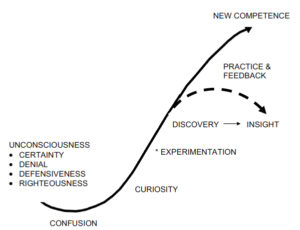“What is necessary to change a person is to change his awareness of himself.”
– Abraham Maslow
There are many challenges that mid level managers face – often related to the reality that many of them are promoted into roles for which they have no previous experience or training. Serving as a high-performing individual contributor doesn’t necessarily prepare someone for engaging, inspiring and managing a team or department of people. Managers require an entire set of soft skills to be effective, such as: the capacity to give and receive feedback, build engagement, communicate effectively, and express praise and appreciation when due. Absence or underdevelopment of these skills can correspond to high turnover, reduced engagement and productivity, and a less effective company culture.
Effective training of mid-level managers can address the root cause of the issue(s) at hand. Such training will begin with facilitating increased awareness – a key high-performance attribute.
What exactly do we mean by increased awareness?
Initiating High Performance Leadership Begins With Awareness
American psychologist Abraham Maslow famously studied the traits of individuals that he felt to be “self-actualized,” or had succeeded during their lifetimes in fulfilling their individual potential (Maslow 1943.) From the study, Maslow identified 14 qualities of self-actualized people, and also came to an unusual and interesting hypothesis:
To a certain extent, a person’s career success and degree of satisfaction with life has to do with awareness, or the percentage of time that an individual was consciously aware of themselves and their environment (as opposed to moving through the day unconsciously, on autopilot.)
Since Maslow’s era, cognitive neuroscientists (in a study cited in US News & World Report), found that we are conscious of only 5% of our cognitive activity – leaving the remaining 95% of our feelings, activities, decisions and behaviors to our unconscious minds.
The Case For Minimal Increases In Awareness
It may be difficult to compute just what percentage of the day we spend in full awareness of ourselves and surroundings – but we do know that if average awareness rests at 5% of our activities, a small increase in that awareness could be a key element in high performance. Therefore putting some attention toward increasing awareness may be well worth our time.
With a minimal increase in awareness, a person becomes capable of noticing opportunities and patterns that they didn’t see before, and leveraging these new perceptions into insight, strategy, and effective plans.
The Discovery Model As A Tool To Increase Awareness
What does the opposite of awareness look like? The so-called “auto-pilot” mode?
We can recognize unconscious or automatic behavior by the symptoms exhibited when it is challenged: certainty, denial, defensiveness, righteousness, and unwillingness to receive feedback or new inputs. These are just a few of the ways that we instinctively protect ourselves and our identities from being disrupted. So how can we break out of our habitual way of seeing things and grow in awareness?
Human beings have devised many ways of breaking through habitual behaviors to achieve new competencies. At Hallett Leadership, we often lead with the Discovery Model as a tool to increase awareness, as in the diagram below:

We begin at the bottom left of the diagram in a condition of “unconsciousness,” and with any or all of the four bulleted qualities of unconsciousness in our posture toward the new and the unknown.
The first step toward increased awareness is confusion.
In the Discovery Model, confusion is actually a good thing. Often times in life, confusion is not a good thing – such as when a person is about to take an examination, or to be tested in any way. In this context, confusion calls to mind the recurring nightmare of the law school graduate, who shows up on the first day of the bar exam only to discover they are completely confused by the questions and have no idea how to respond.
But when you seek to experience new behaviors so that you can be more effective, and lean in toward high performance, the confusion represents the breaking apart of your fixed beliefs and old habits. Old, well-worn neurological pathways are being dismantled, and the brain is just starting out in the quest to create newer, more effective pathways.
The student of high performance leadership consents to the discomfort and uncertainty of the confusion stage, in order to engage their curiosity – the stage at which they are properly ascending the line in the diagram toward their new competence, or awareness.
We will discuss the other stages of the Discovery Model at a later date.
Conclusion
Breaking out of a fixed way of doing things, and shining the light of awareness on habits and modes of being that are no longer working can be uncomfortable at times. But for those who want to strike at the root of what is preventing high performance leadership from appearing in their company, developing and nurturing this awareness is essential. As always, Hallett Leadership is available to discuss the topic of developing your managers into high performance leaders.
References
Maslow, A.H. (1943). A theory of human motivation. Psychological Review 50(1), 370-396. doi:10.1037/h0054346





